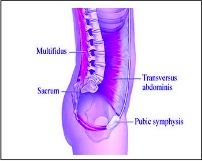Sacroiliac Joint Dysfunction
- Sacroiliac Joint (SIJ) Dysfunction is becoming increasingly diagnosed and treated as a contributing factor to low back pain
- SIJ is the joint formed between the two halves of the pelvis and the sacrum (the triangular-shaped bone at the base of the spine)
- The SIJ’s function is to distribute load between the lower limbs and the spine
- There is a very small amount of movement that occurs at the SIJ and if this is not controlled, it can result in an unstable joint and pain
- The SIJ is a strong synovial joint which is held together by bony alignment, ligaments and muscles; particularly the ‘core muscles’
Interesting facts
- 30% of low back pain is believed to be caused by the SIJ
- The SIJ provides attachment sites for 30-odd muscles

- SIJ injuries can result from a fall onto the bottom or knee, a lifting injury or may even occur during labour
- Pregnancy often causes SIJ pain as ligaments become stretched and the pelvis is under more strain.
Symptoms/ what to look out for
- Pain with sitting, moving from sitting to standing, rolling in bed
- Pain in the pelvic and buttock region with walking and standing on one leg
- Groin pain
- Altered control of bladder function
- Pain maps: never above L5, may refer down leg
- Patients may describe as sciatica
- Pain is recurring, triggered by bending, lifting
- Commonly idiopathic
- Initial episodes may be caused by: pregnancy, trauma from fall or motor vehicle accident, hard braking, transverse force on the pelvis
- Worse when loaded, eg standing, walking
Management options
- Physiotherapy guided ‘core muscle’ strengthening exercises
- Use of Real-time Ultrasound to view, correct and strengthen core muscle contractions

- Pelvic Belt for pregnancy
- Your doctor may prescribe anti-inflammatory medication
- Manual therapy to ‘realign’ the pelvis and SIJ
- Pilates or core based exercises
Hints for self-management
- Avoid high load transfer activities such as running, hopping, jumping
- Stretching tight muscles around the pelvis may help relieve symptoms (glutes, quads)
- Heat packs can help relieve tight muscles
- If symptoms come on during pregnancy, a SIJ belt may be advised for you to wear, as this can help support the pelvis
More information
- Your core muscles play an integral role in the stability of the SIJ
- Core muscles include: Pelvic Floor, Transverse Abdominus, Diaphragm and Multifidus
- Low back pain has been proven to inhibit activation of the core muscles
- Contributing factors to SIJ dysfunction include: muscle imbalances, leg length differences, poor posture, poor core stability, biomechanical abnormalities
At Sydney Sports and Orthopaedic Physiotherapy our highly qualified physiotherapists specialise in the assessment, treatment and prevention of neuromusculoskeletal injuries.
Contact us today – 9252 5770
This handout was prepared by Sydney Sports and Orthopaedic Physiotherapy and is intended as a general information service. Please note that the information provided is not intended as a substitute for advice from a registered physician or healthcare professional. If symptoms persist, please consult your doctor.

